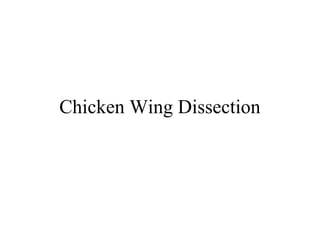
Chicken wing prac hands 0n
- 2. Background Certain principles of muscle function help us to understand bone-muscle relationships. First, skeletal muscle contracts only if it is stimulated by the nervous system. Second, skeletal muscles usually produce movements by pulling on bones across joints. The bones serve as levers and the joints serve as fulcrums. Third, muscles usually lie next to the bones they move. And,finally,muscles usually act in groups.
- 3. Materials Gather dissection material: tray, scissors, chicken wing and probes.
- 4. Procedure Step 1 • Carefully extend the wing to find out how many major parts it has. • Include a photo of the external structure. Label: upper arm, elbow, lower arm, and hand. (wing tip).
- 5. Procedure Step 2 Use scissors to cut the skin as shown . Try not to cut through the muscles located beneath the skin
- 6. Procedure Step 3 Remove as much skin from the thickest part of the wing as possible, exposing the underlying muscle Observe the muscle. The muscles are bundles of pale pink tissue that surround the bone.
- 7. Procedure Step 4 • Photograph any yellow tissue found in small clumps on the inside of the skin. This is a type of connective tissue called fat.
- 8. Procedure step 5 • Remove any remaining skin from the elbow joint. • Locate, and label a tendon. Tendons are shiny white tissues at the ends of the muscles that attach muscles to bones.
- 9. Procedure step 6 • Locate, and label a ligament. Ligaments are shiny white tissue at the ends of bone.
- 10. Procedure step 7 • Locate, photograph and label cartilage. Cartilage is the slippery shiny white tissue at the ends of bone.
- 11. Procedure step 8 • Once you have identified the following parts: skin, muscle, tendon, ligament, cartilage and bone, call your instructor over for a group oral quiz and initials.
- 12. Procedure step 9 Clean UP!!! • Throw away all chicken wing parts into the designated container. • Clean dissection tools and place into beaker. Stack tray next to beaker. Wash your hands thoroughly with soap and water.
- 13. Your own reading/research Use information from leaflets, newspapers, books and the internet to find out the following: • What is salmoneliosis? • How do people catch Salmonella? • What can a person do to prevent this illness?
- 14. Questions: (hint hint! write them in your notebook!!!) 1. What function is performed by ligaments?_________________________________________ What is the function of a tendon? ________________________________________________ 2. What is more proximal, the insertion or the origin for the attachment of the muscles in the chicken wing? 3. What tissue is referred to when one speaks of the “meat” of the chicken? 4. Name the two main types of movement that occur when a wing is raised and lowered in flight. 5. What bone in the wing is connected to the chicken’s body at the shoulder? ____________________ 6. Name the two bones found in the forearm of the wing. ________________ _____________________ 7. What type of joint connects the wing to the body? _______________________________________ 8. What type of joint moves the wing at the elbow? 9. The muscle you observed is classified as what type of muscle tissue? ____________________________ •
